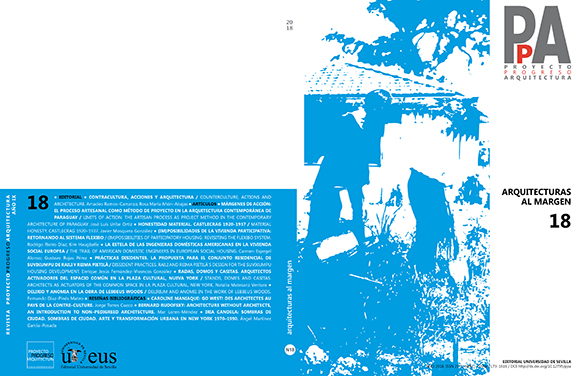HONESTIDAD MATERIAL. CASTLECRAG 1920-1937 / MATERIAL HONESTY. CASTLECRAG 1920-19
DOI:
https://doi.org/10.12795/ppa.2018.i18.02Keywords:
Australia, Castlecrag, naturaleza, entorno, Knitlock, Griffin / Australia, Nature, Environment, GriffinAbstract
RESUMEN La arquitectura producida a comienzos del siglo XX por la denominada Escuela de Chicago, generó un estilo reconocible más allá de sus fronteras. Tanto es así que muchos de los arquitectos norteamericanos pertenecientes a aquel período han sido considerados como miembros del mismo grupo. Tal es el caso de Marion Mahony Griffin y Walter Burley Griffin, quienes además en su juventud fueron colaboradores de Frank Lloyd Wright junto con el que desarrollaron múltiples proyectos de las Prairie Houses. Sin embargo, una vez comienzan su práctica profesional de manera autónoma en el continente australiano, la distancia establecida entre América y Oceanía les permite evolucionar lo aprendido de sus maestros hacia un lenguaje personal alejado de sus referencias.
Aún siendo reconocibles sus orígenes, la arquitectura producida para la comunidad residencial de Castlecrag, muestra unas construcciones singulares, ajenas a lo que en su país natal se estaba produciendo, y que por tanto permite afirmar que no son unos simples discípulos de la Escuela de Chicago, sino unos arquitectos en busca de un lenguaje propio, desde la libertad de quien trabaja en la distancia.
SUMMARY The architecture produced in the early 20th century by what is known as the Chicago School led to a style that can be found far beyond its borders. Such is the case that many North American architects from that period have been considered members of the same group. They include Marion Mahony Griffin and Walter Burley Griffin, who also collaborated with Frank Lloyd Wright early on, developing several Prairie House projects. However, once they embarked on their own independent professional work on the Australian continent, the distance between America and Oceania allowed them to evolve what they had learnt from their masters towards a more personal language that strayed from their references.
Even with recognizable origins, the architecture produced for the residential community of Castlecrag reflects singular structures quite unlike what was being produced in their home country and which, therefore, proved they were not simply disciples of the Chicago School but rather architects in search of their own language from the freedom of working at a distance.
KEY WORDS Australia, Castlecrag, Nature, Environment, Knitlock, Griffin
Downloads
References
BANERJI, Shiben. “Inhabiting the world: Architecture, Urbanism, and the Global Moral – Politics of Marion Mahony and Walter Burley Griffin”. Director: Arindam Dutta. Tesis doctoral. Massachusets Institute of Technology MIT, 2015.
BIRRELL, James. Walter Burley Griffin. Brisbane: University of Queensland Press, 1964.
BOYD, Robin. Australia’s home: its origins, builders and occupiers. Melbourne: Melbourne University Press, 1991.
EMERSON, Ralph Waldo. Nature. Boston: James Munroe and Company, 1836.
GRIFFIN, Dustin. The writtings of Walter Burley Griffin. Nueva York: Cambridge University Press, 2008.
GRIFFIN, Marion Mahony. The Magic of America [en línea]. Chicago: The Art Institute of Chicago, 1949 (2008). [consulta: 05-07-2017] Disponible en: http://www.artic.edu/magicofamerica/index.html.
JOHNSON, Donald Leslie. The Architecture of Walter Burley Griffin. South Melbourne: Macmillan Company of Australia, 1977.
SULLIVAN, Louis Henry. The Public Papers. Chicago: Editado por Robert Twombly. Chicago: Chicago University Press, 1988.
TAUT, Bruno. 1997. Escritos expresionistas 1919-1920. Madrid: El Croquis Editorial, 1997.
TURNBULL, Jeffrey. 2006. The Architecture of Walter Burley Griffin: Concrete Applications. En Second International Congress on Construction History, 3: 3133 – 3151. Londres, 2006.
ULARGUI AGURRUZA, Jesús. De Richardson a Sullivan. Un nuevo espacio social. Barcelona: Fundación Caja de Arquitectos, 2007.
WALKER, Meredith, KABOS, Adrienne, y WEIRICK, James. Building for Nature. Walter Burley Griffin and Castlecrag. New South Wales: Walter Burley Griffin Society, 1994.
Published
How to Cite
Issue
Section
License
Las ediciones impresa y electrónica de esta Revista son editadas por el Secretariado de Publicaciones de la Universidad de Sevilla, siendo necesario citar la procedencia en cualquier reproducción parcial o total.
Salvo indicación contraria, todos los contenidos de la edición electrónica se distribuyen bajo una licencia de uso y distribución “Creative Commons Atribución-NoComercial-SinDerivar 4.0 Internacional” ![]() . Puede consultar desde aquí la versión informativa y el texto legal de la licencia. Esta circunstancia ha de hacerse constar expresamente de esta forma cuando sea necesario.
. Puede consultar desde aquí la versión informativa y el texto legal de la licencia. Esta circunstancia ha de hacerse constar expresamente de esta forma cuando sea necesario.
Los autores/as que publiquen en esta revista aceptan las siguientes condiciones:
- Los autores/as conservan los derechos de autor y ceden a la revista el derecho de la primera publicación, con el trabajo registrado con la licencia de atribución de Creative Commons, que permite a terceros utilizar lo publicado siempre que mencionen la autoría del trabajo y a la primera publicación en esta revista.
- Los autores/as pueden realizar otros acuerdos contractuales independientes y adicionales para la distribución no exclusiva de la versión del artículo publicado en esta revista (p. ej., incluirlo en un repositorio institucional o publicarlo en un libro) siempre que indiquen claramente que el trabajo se publicó por primera vez en esta revista.
- Se permite y recomienda a los autores/as a publicar su trabajo en Internet (por ejemplo en páginas institucionales o personales) antes y durante el proceso de revisión y publicación, ya que puede conducir a intercambios productivos y a una mayor y más rápida difusión del trabajo publicado (vea The Effect of Open Access).









